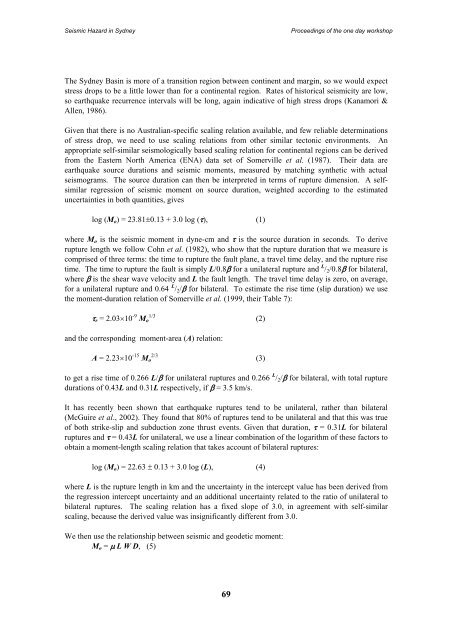Landslides in the Sydney Basin - Geoscience Australia
Landslides in the Sydney Basin - Geoscience Australia
Landslides in the Sydney Basin - Geoscience Australia
- No tags were found...
You also want an ePaper? Increase the reach of your titles
YUMPU automatically turns print PDFs into web optimized ePapers that Google loves.
Seismic Hazard <strong>in</strong> <strong>Sydney</strong>Proceed<strong>in</strong>gs of <strong>the</strong> one day workshopThe <strong>Sydney</strong> Bas<strong>in</strong> is more of a transition region between cont<strong>in</strong>ent and marg<strong>in</strong>, so we would expectstress drops to be a little lower than for a cont<strong>in</strong>ental region. Rates of historical seismicity are low,so earthquake recurrence <strong>in</strong>tervals will be long, aga<strong>in</strong> <strong>in</strong>dicative of high stress drops (Kanamori &Allen, 1986).Given that <strong>the</strong>re is no <strong>Australia</strong>n-specific scal<strong>in</strong>g relation available, and few reliable determ<strong>in</strong>ationsof stress drop, we need to use scal<strong>in</strong>g relations from o<strong>the</strong>r similar tectonic environments. Anappropriate self-similar seismologically based scal<strong>in</strong>g relation for cont<strong>in</strong>ental regions can be derivedfrom <strong>the</strong> Eastern North America (ENA) data set of Somerville et al. (1987). Their data areearthquake source durations and seismic moments, measured by match<strong>in</strong>g syn<strong>the</strong>tic with actualseismograms. The source duration can <strong>the</strong>n be <strong>in</strong>terpreted <strong>in</strong> terms of rupture dimension. A selfsimilarregression of seismic moment on source duration, weighted accord<strong>in</strong>g to <strong>the</strong> estimateduncerta<strong>in</strong>ties <strong>in</strong> both quantities, giveslog (M o ) = 23.810.13 + 3.0 log (), (1)where M o is <strong>the</strong> seismic moment <strong>in</strong> dyne-cm and is <strong>the</strong> source duration <strong>in</strong> seconds. To deriverupture length we follow Cohn et al. (1982), who show that <strong>the</strong> rupture duration that we measure iscomprised of three terms: <strong>the</strong> time to rupture <strong>the</strong> fault plane, a travel time delay, and <strong>the</strong> rupture risetime. The time to rupture <strong>the</strong> fault is simply L/0.8 for a unilateral rupture and L / 2 /0.8 for bilateral,where is <strong>the</strong> shear wave velocity and L <strong>the</strong> fault length. The travel time delay is zero, on average,for a unilateral rupture and 0.64 L / 2 / for bilateral. To estimate <strong>the</strong> rise time (slip duration) we use<strong>the</strong> moment-duration relation of Somerville et al. (1999, <strong>the</strong>ir Table 7): r = 2.0310 -9 M o1/3(2)and <strong>the</strong> correspond<strong>in</strong>g moment-area (A) relation:A = 2.2310 -15 M o2/3(3)to get a rise time of 0.266 L/ for unilateral ruptures and 0.266 L / 2 / for bilateral, with total rupturedurations of 0.43L and 0.31L respectively, if = 3.5 km/s.It has recently been shown that earthquake ruptures tend to be unilateral, ra<strong>the</strong>r than bilateral(McGuire et al., 2002). They found that 80% of ruptures tend to be unilateral and that this was trueof both strike-slip and subduction zone thrust events. Given that duration, = 0.31L for bilateralruptures and = 0.43L for unilateral, we use a l<strong>in</strong>ear comb<strong>in</strong>ation of <strong>the</strong> logarithm of <strong>the</strong>se factors toobta<strong>in</strong> a moment-length scal<strong>in</strong>g relation that takes account of bilateral ruptures:log (M o ) = 22.63 0.13 + 3.0 log (L), (4)where L is <strong>the</strong> rupture length <strong>in</strong> km and <strong>the</strong> uncerta<strong>in</strong>ty <strong>in</strong> <strong>the</strong> <strong>in</strong>tercept value has been derived from<strong>the</strong> regression <strong>in</strong>tercept uncerta<strong>in</strong>ty and an additional uncerta<strong>in</strong>ty related to <strong>the</strong> ratio of unilateral tobilateral ruptures. The scal<strong>in</strong>g relation has a fixed slope of 3.0, <strong>in</strong> agreement with self-similarscal<strong>in</strong>g, because <strong>the</strong> derived value was <strong>in</strong>significantly different from 3.0.We <strong>the</strong>n use <strong>the</strong> relationship between seismic and geodetic moment:M o = L W D, (5)69
















